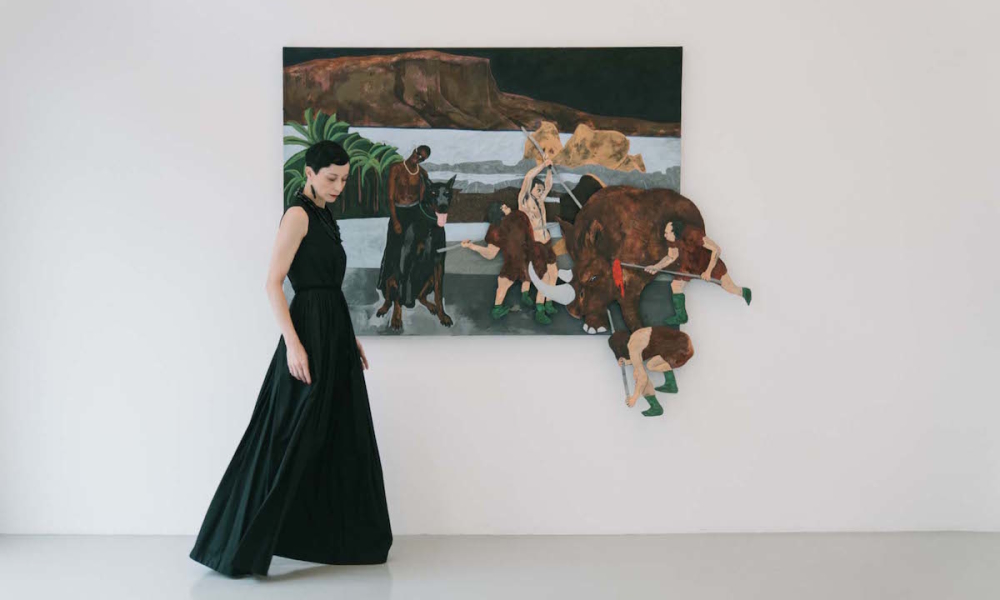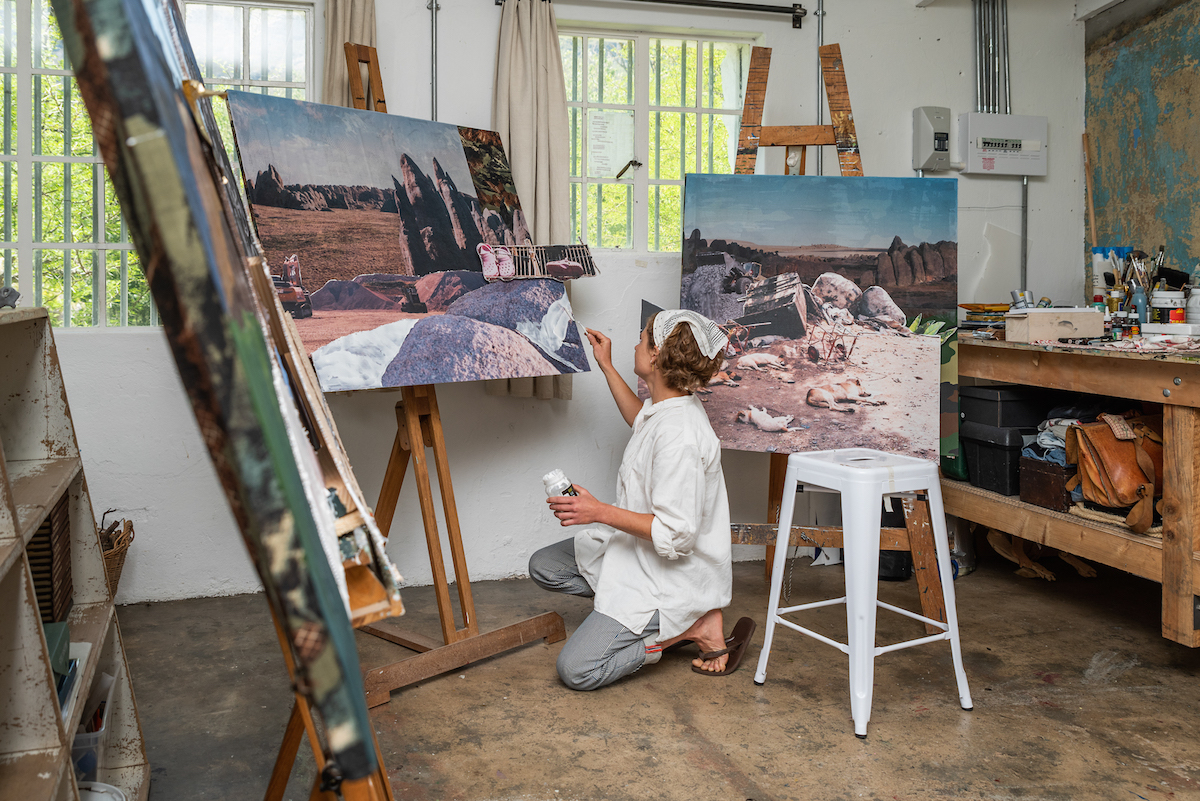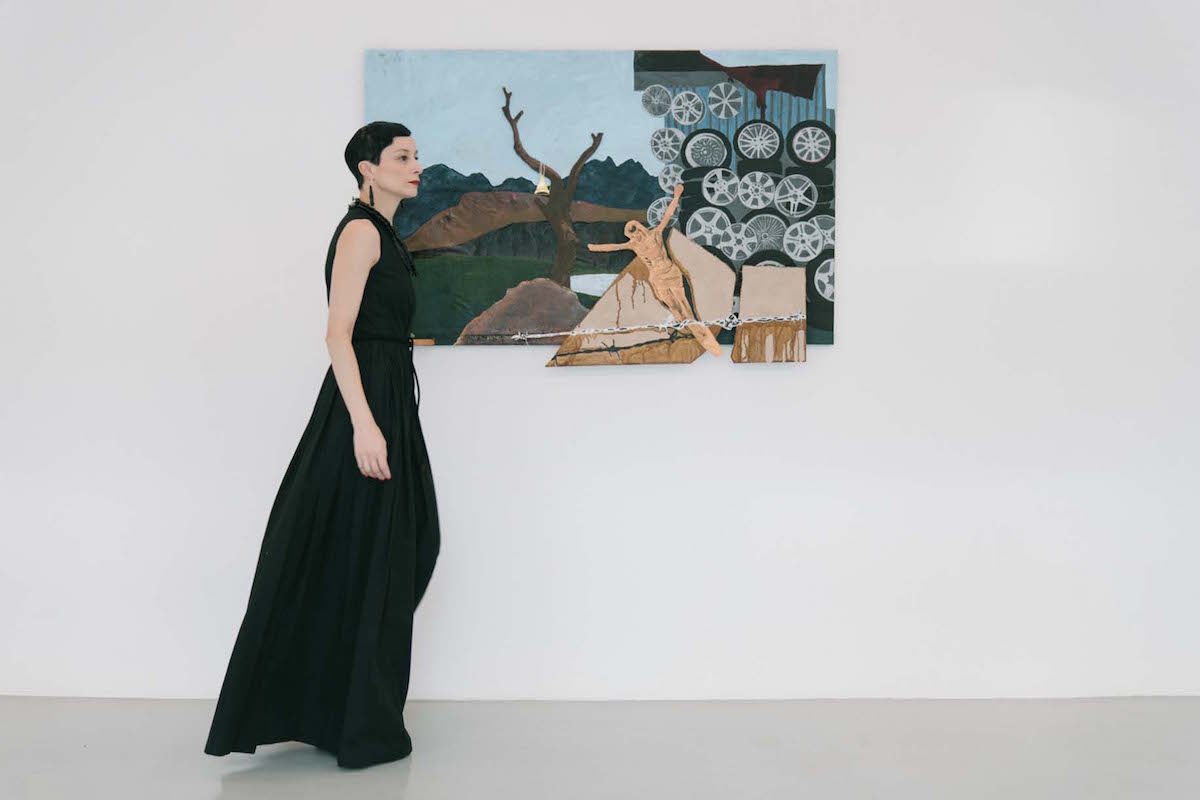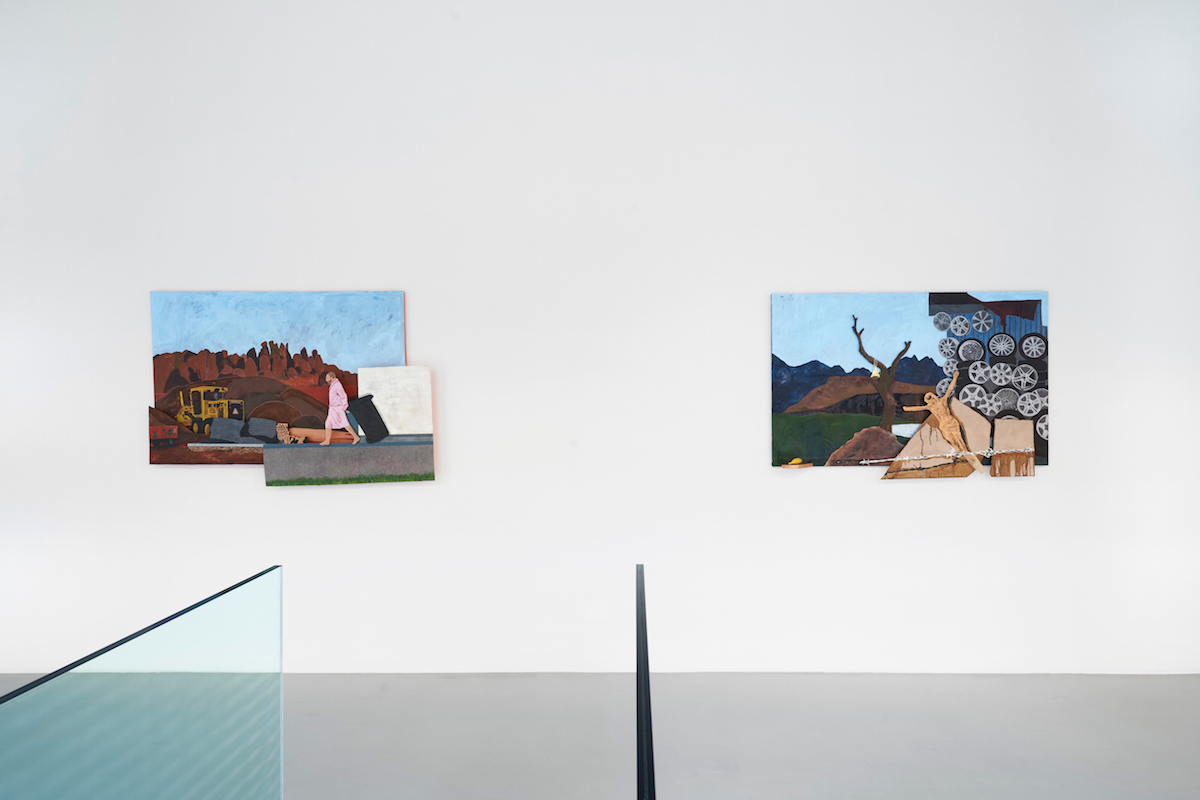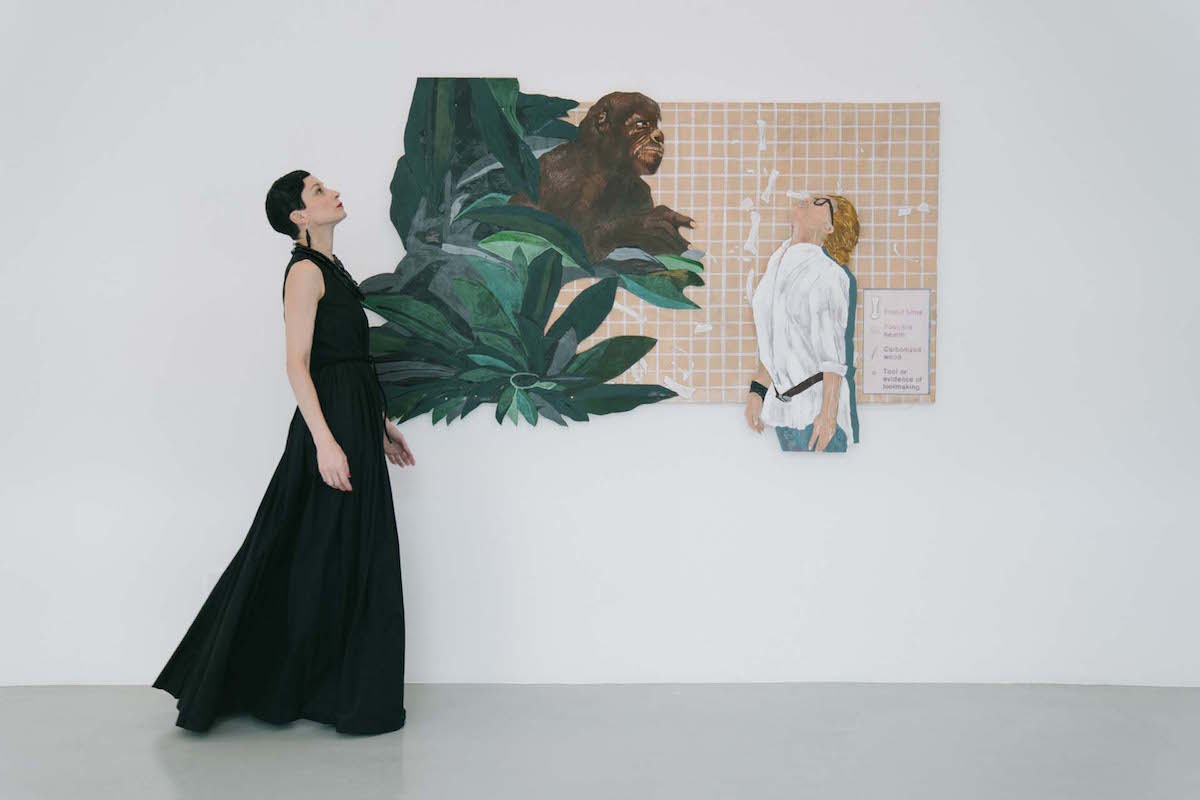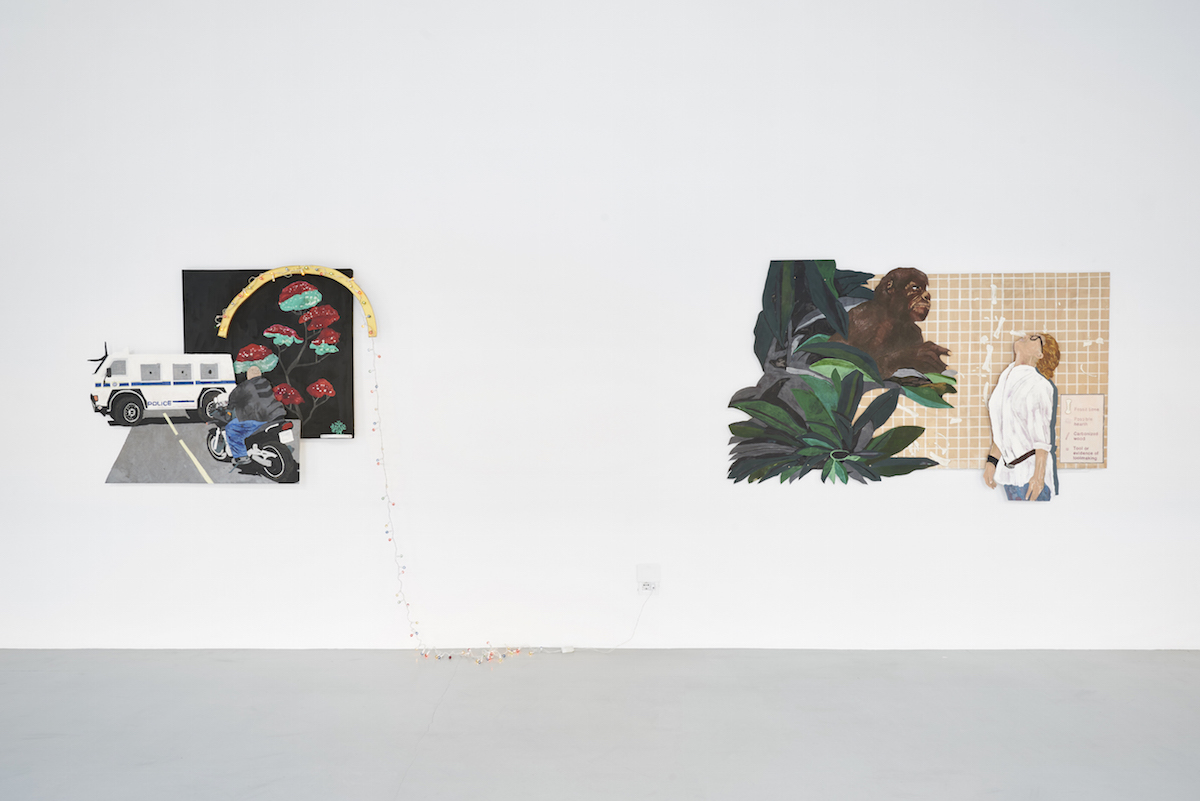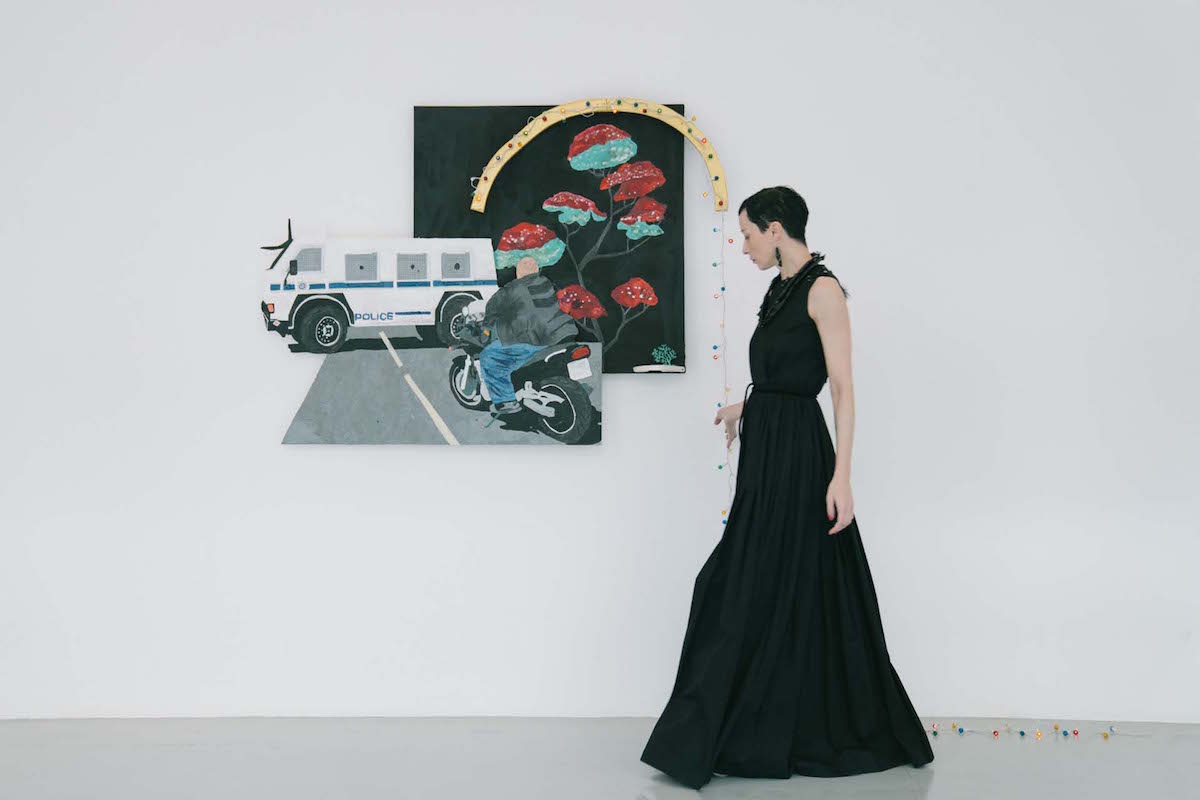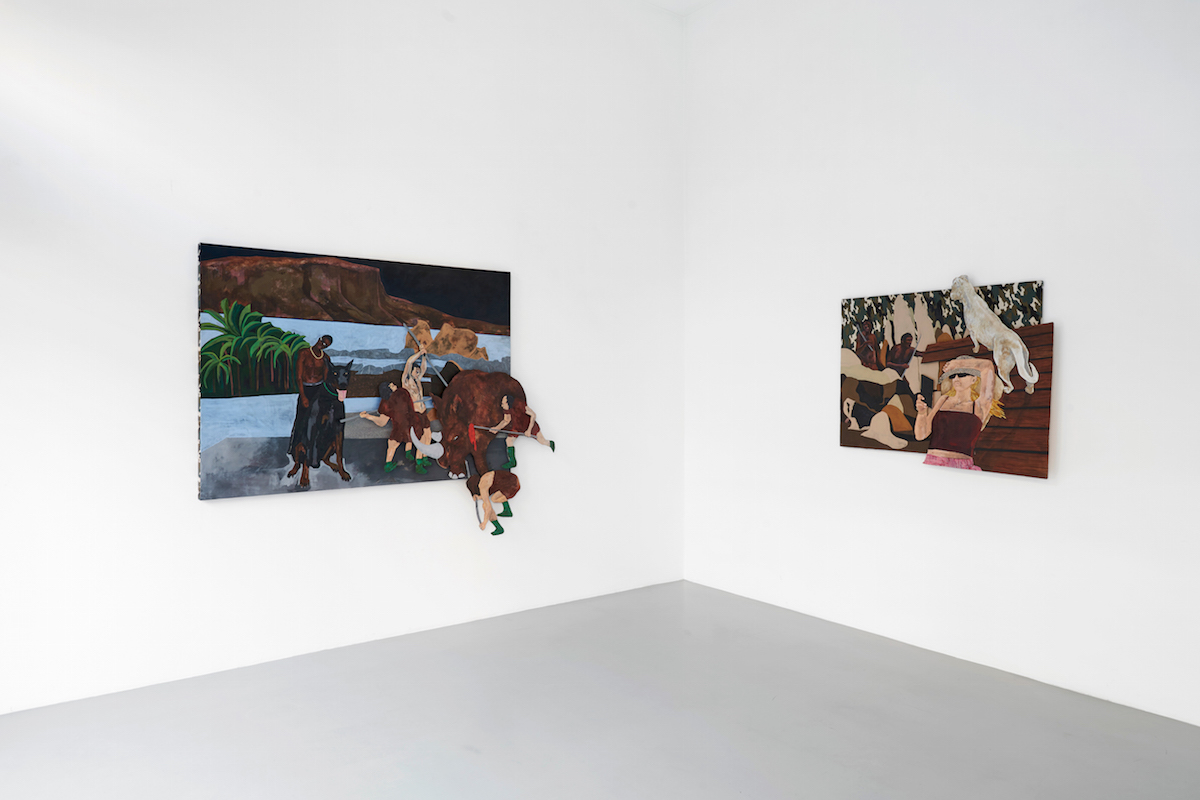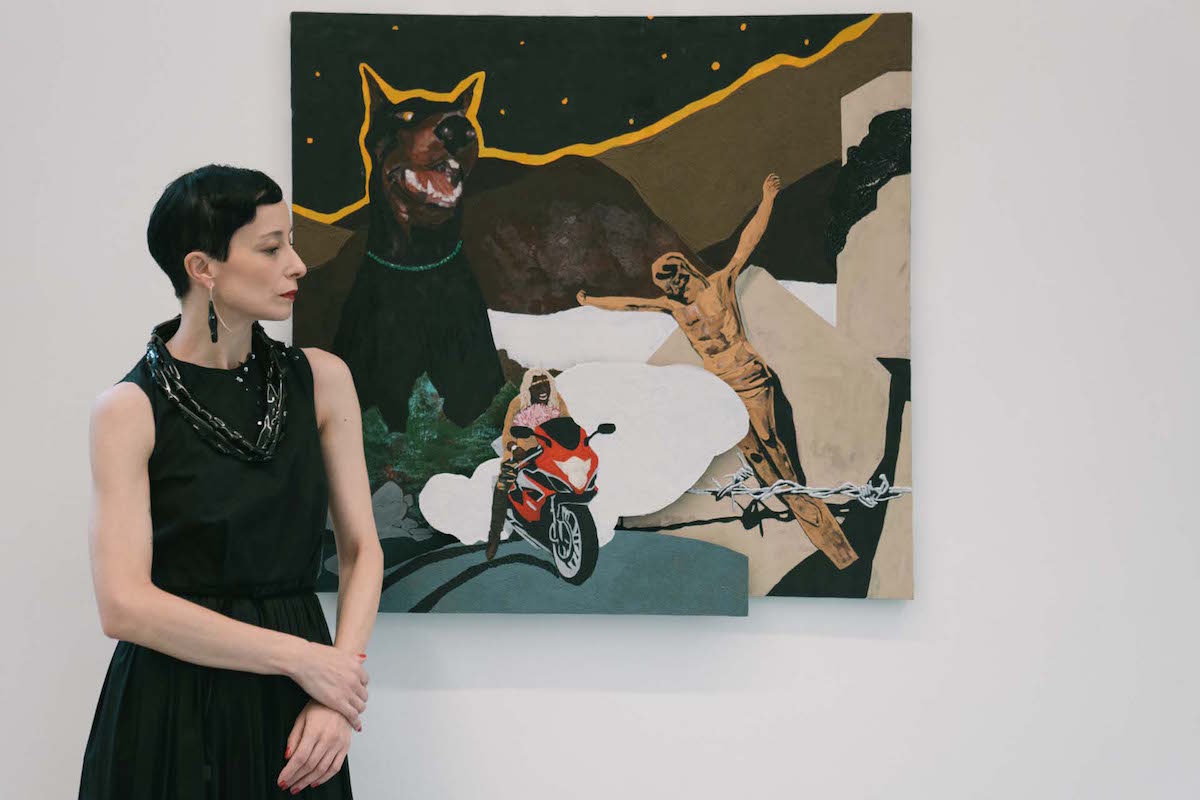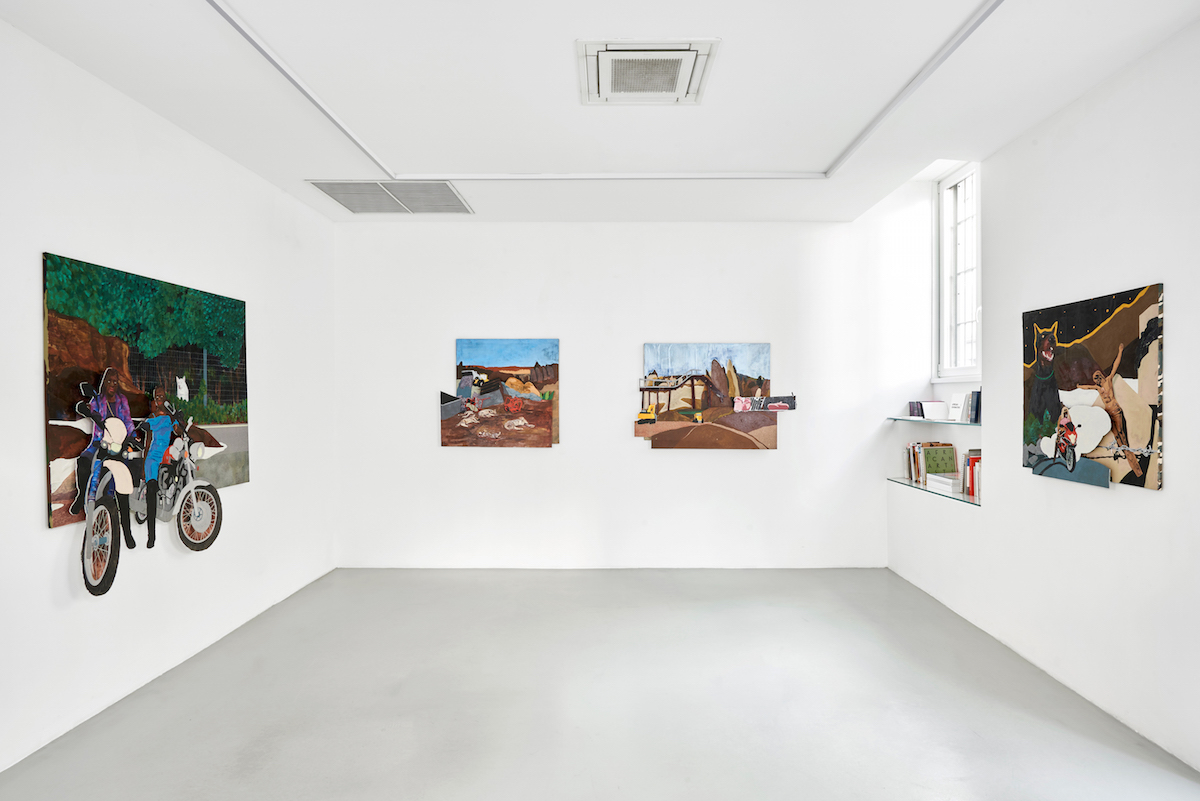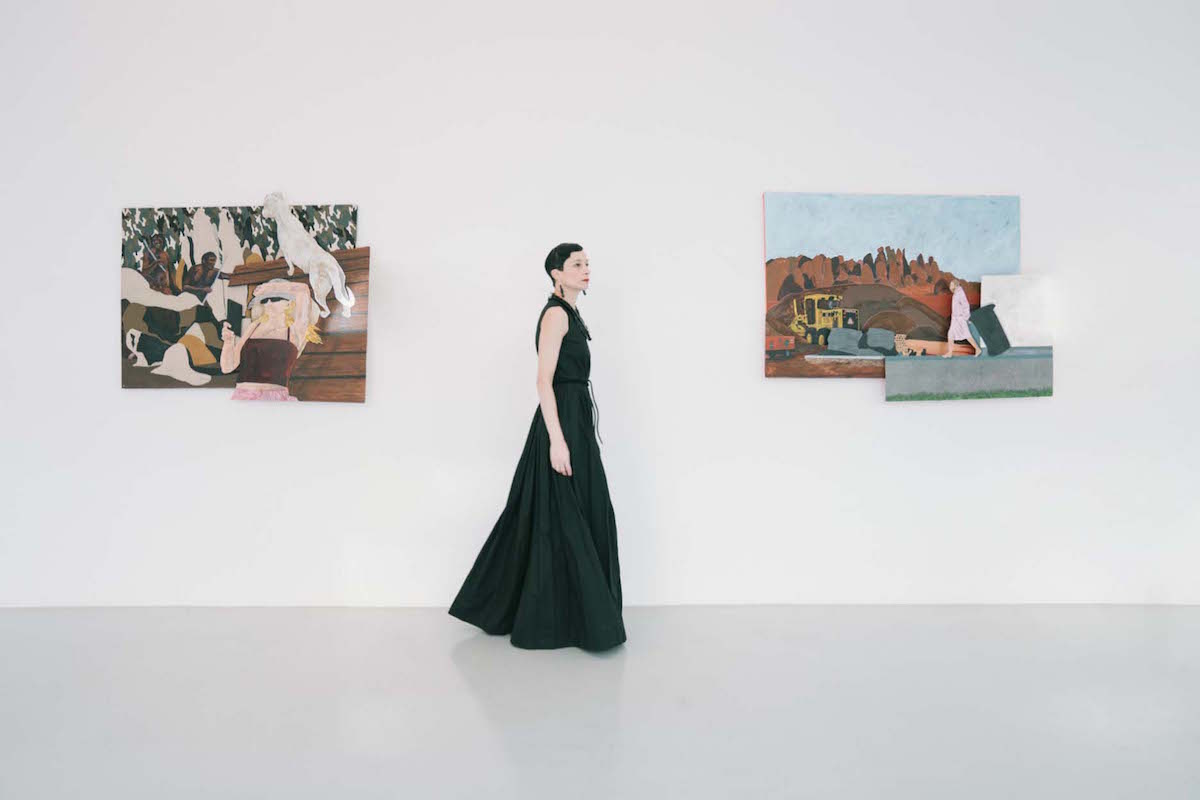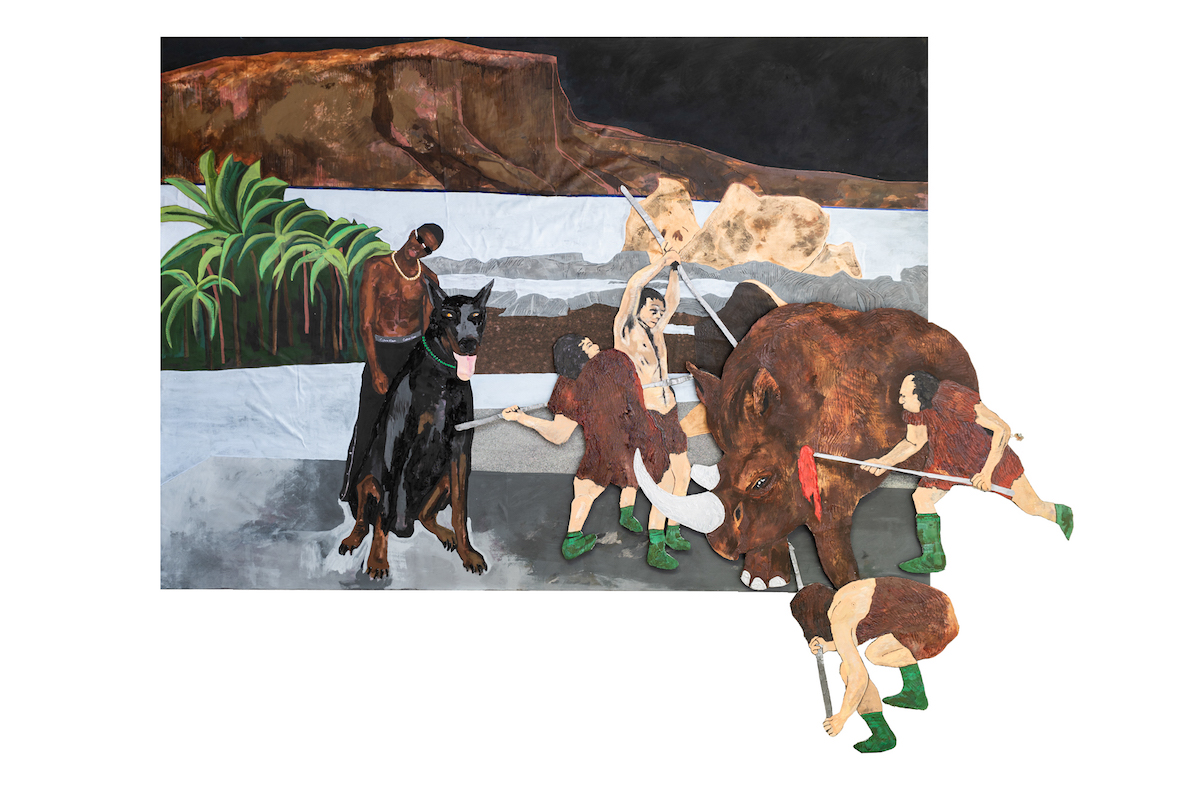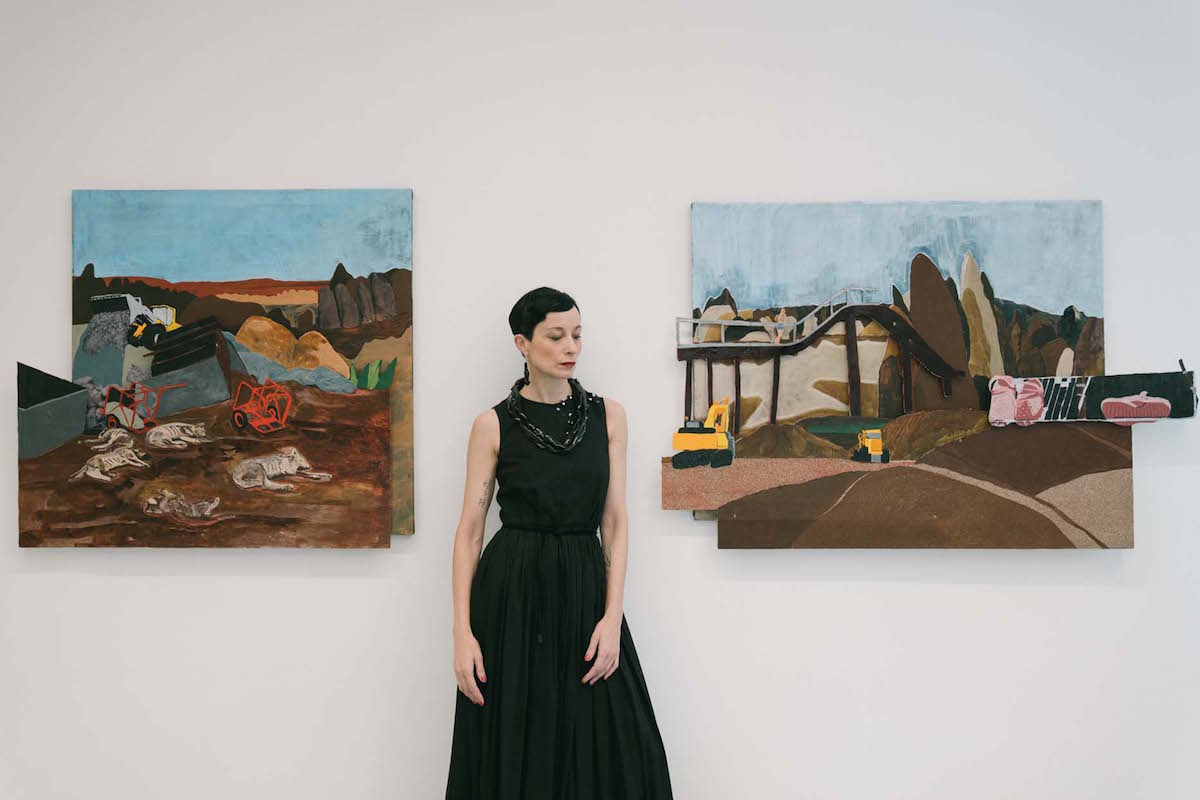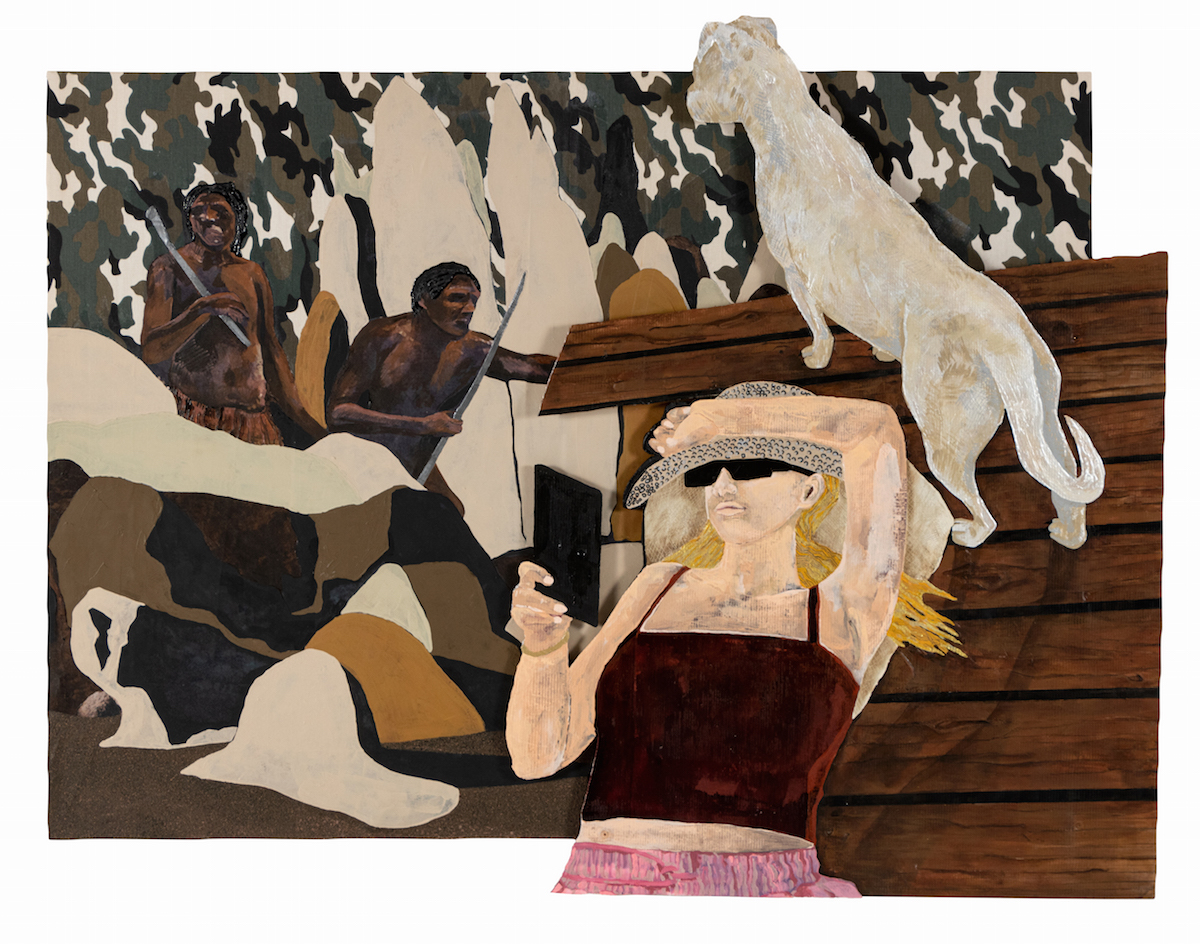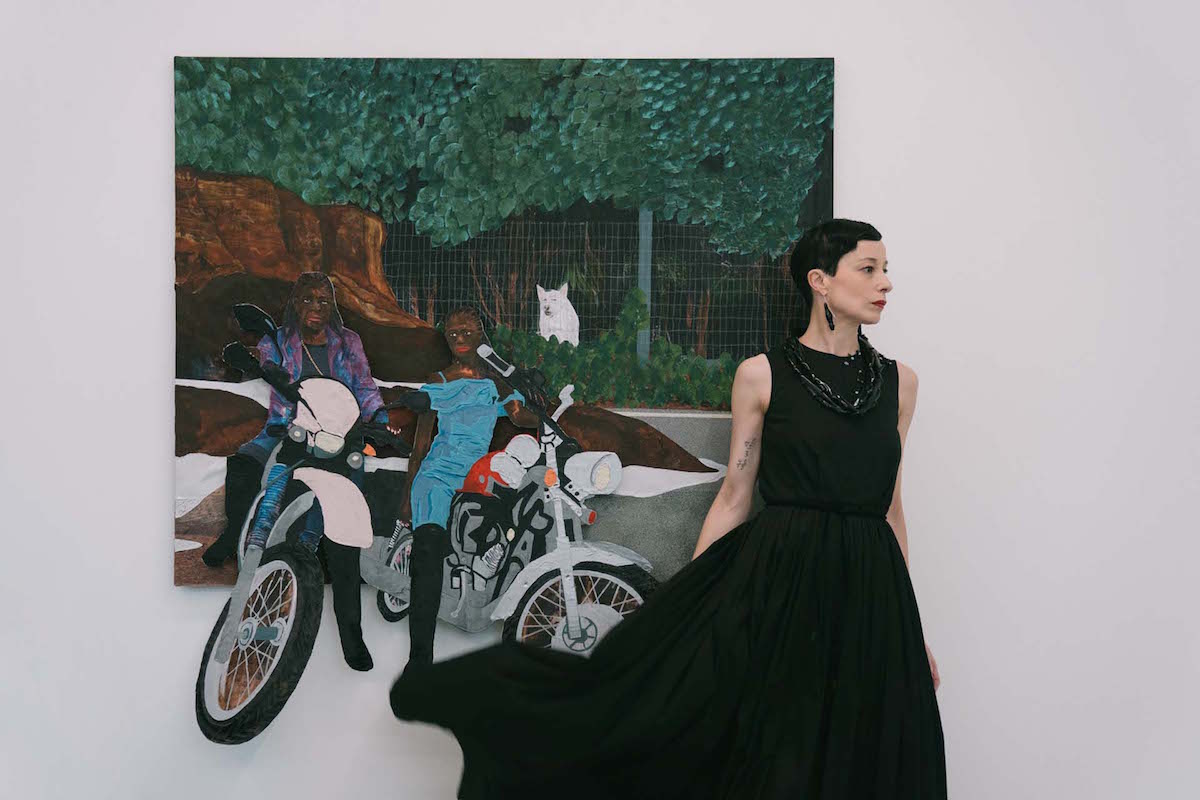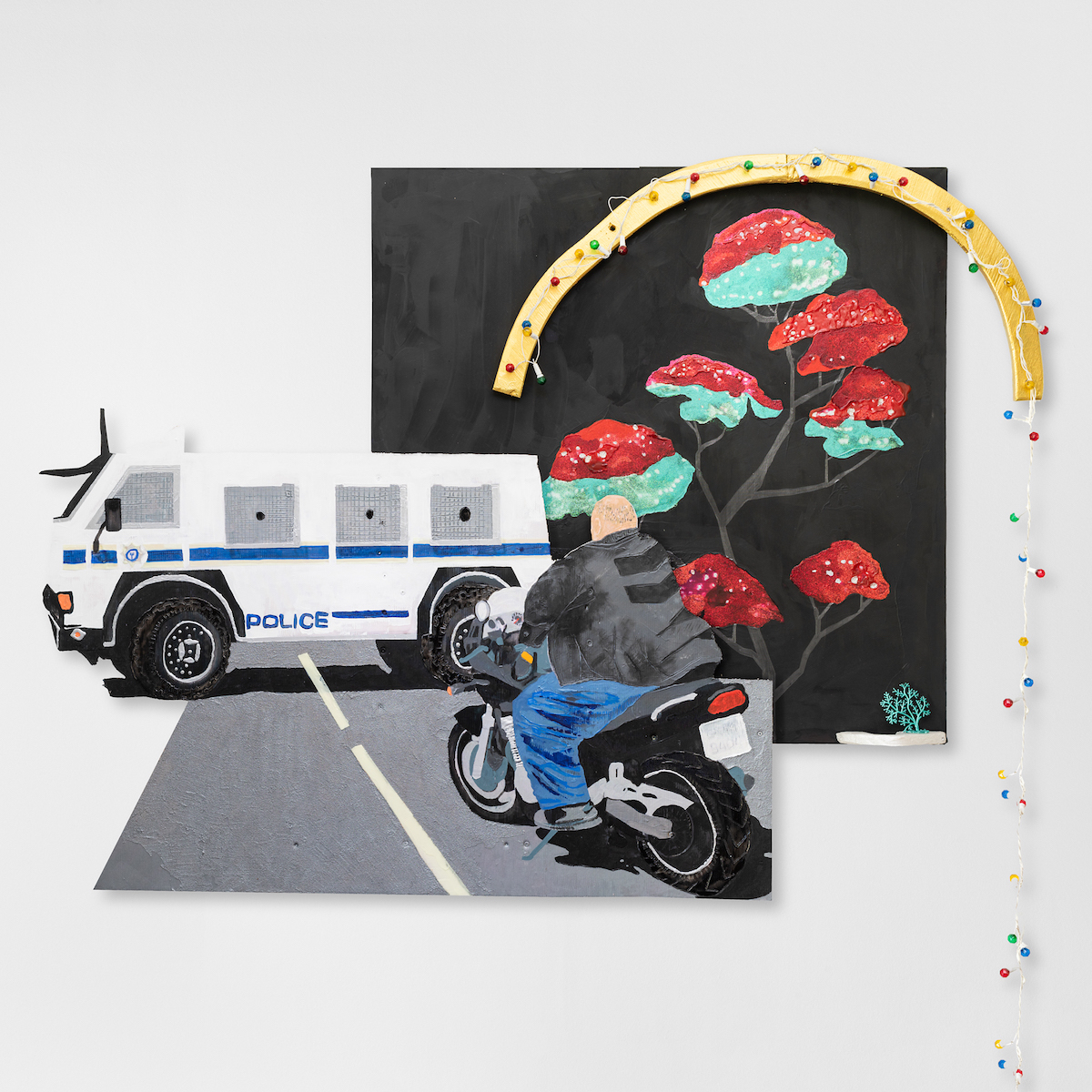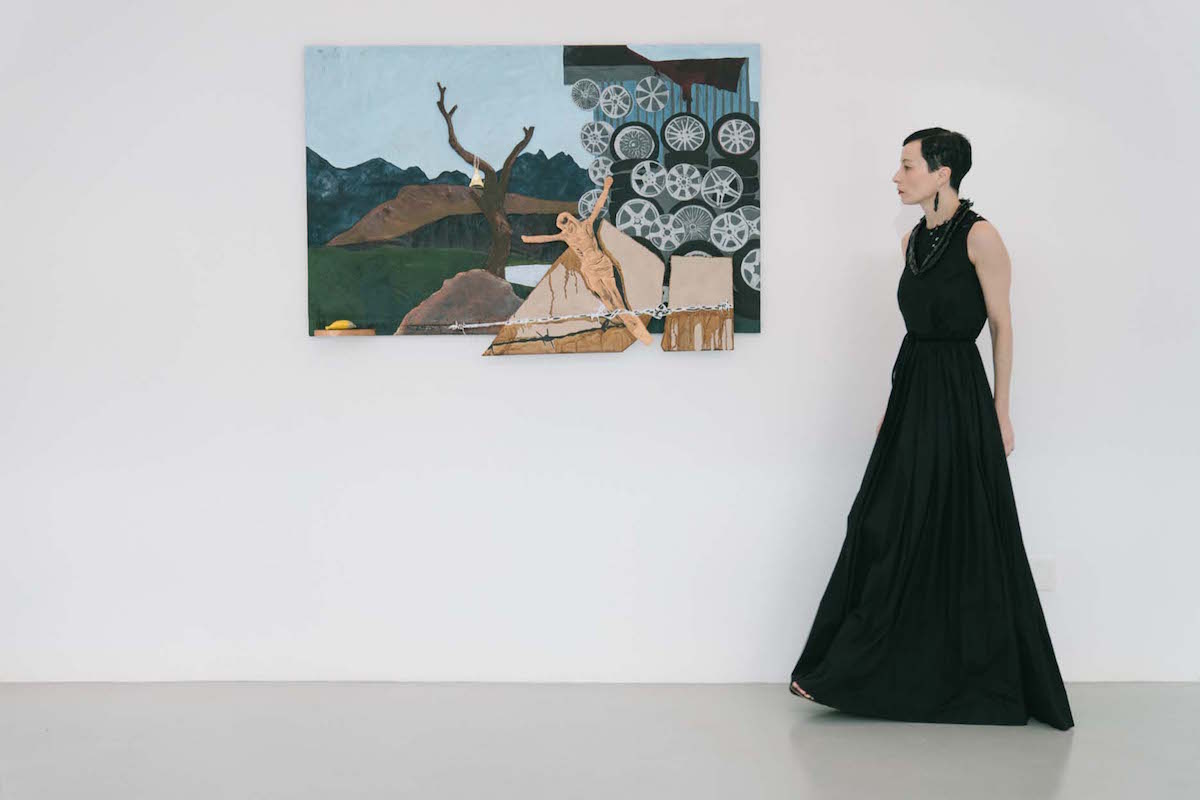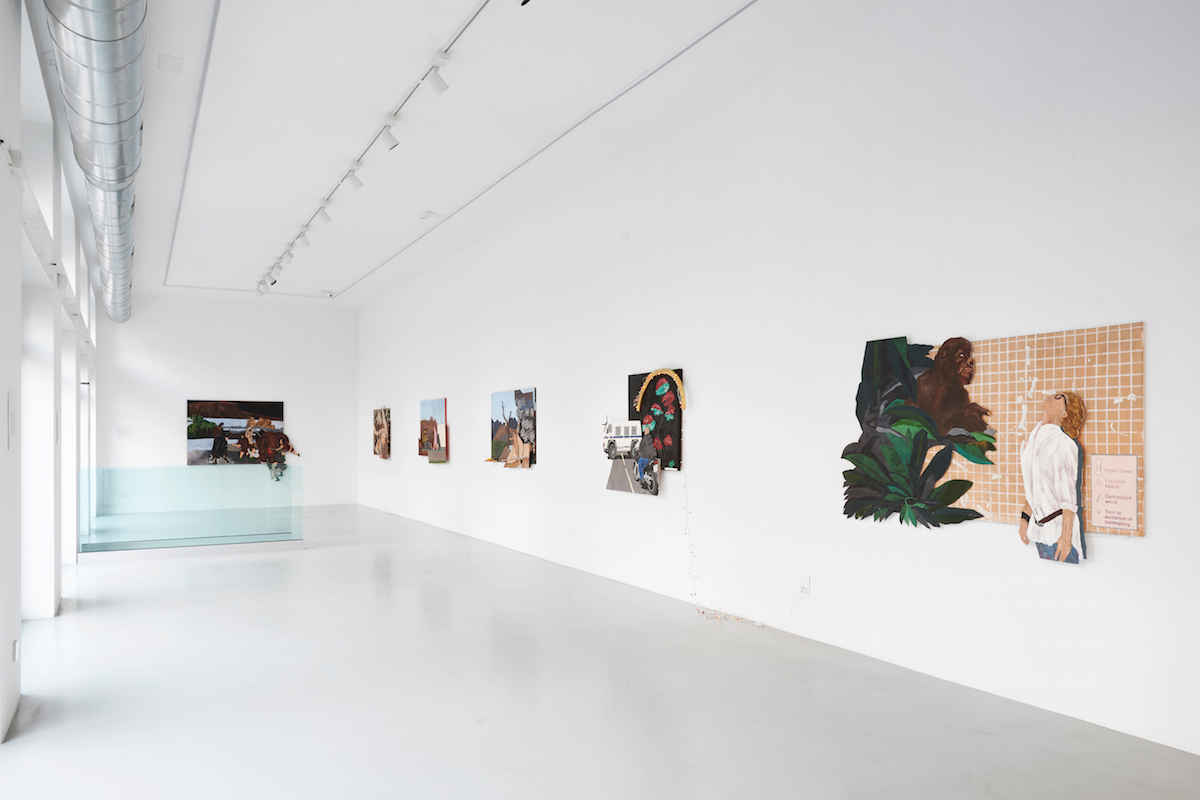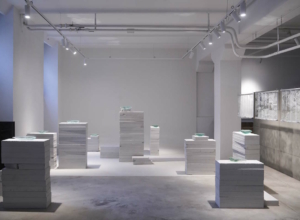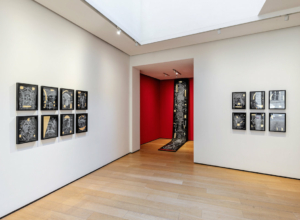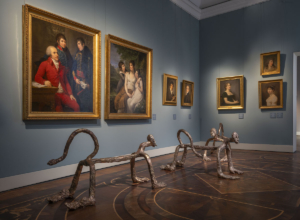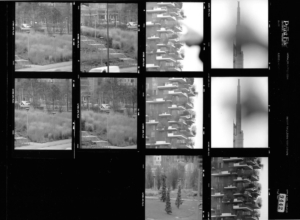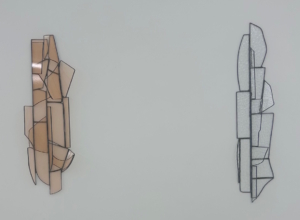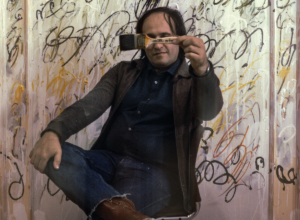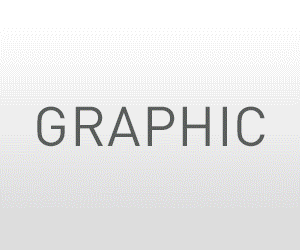Echo Me / Here I am / Ecco Mi è la prima personale in Italia che Osart gallery dedica all’artista Katharien De Villiers (Sudafrica, 1991). La mostra, a partire dal titolo, è l’affermazione di una presenza fisica e il segnale di un’eco da un emisfero all’altro, di un messaggio che si riverbera. Il messaggio di Katharien attraversa il tempo e lo spazio con una moltitudine di riferimenti, oggetti del passato che rimodulano la percezione del presente, immagini da mondi distanti che coesistono all’interno di opere polimateriche, in cui pittura e scultura si fondono.
Echo Me / Here I am / Ecco Mi is the first Italian solo show by Katharien De Villiers (South Africa, 1991) that is currently taking place at Osart gallery. Starting from the title, the exhibition is the confirmation of a physical presence and the sign of an echo from one hemisphere to another, of a message that reverberates. Katharien’s message traverses time and space with a multitude of references: objects from the past that remodulate the perception of the present, images of distant worlds that coexist within multimaterial works that merge painting and sculpture.
Katharien De Villiers in the studio, 2021. Courtesy the artist and Osart Gallery, Ph. Paris Brummer
Francesca Interlenghi: Vorrei iniziare chiedendoti come ti sei avvicinata alla pittura e che tipo di evoluzione ha subito la tua pratica artistica negli anni?
Katherine De Villiers: Ho conseguito un master in installazioni artistiche, per il semplice fatto che non ero interessata a una specializzazione. L’installazione mi ha permesso di concentrarmi sulla concretezza della materia, senza dover necessariamente scegliere tra scultura, disegno o fotografia. E mi ha introdotta e aperta al mondo relazionale in cui le mie opere amano vivere, alimentando il mio interesse per l’esplorazione delle dinamiche relative allo spazio espositivo. È stato solo uno o due anni dopo aver conseguito la laurea che ho iniziato a sviluppare il mio stile di pittura: uno stile fatto di fotografie assemblate con la tecnica del collage, tridimensionali e raggruppate in immagini casuali, dipinte in modo da formare un tutt’uno coeso. La pittura si è resa necessaria da un punto di vista commerciale, ma trovare un medium che fosse sintesi dei miei molteplici interessi ha richiesto molto tempo. Negli ultimi sei anni ha preso forma un linguaggio visivo fondato su materialità, tattilità, dimensione e narrazione.
Katharien De Villiers, Echo Me / Here I am / Ecco Mi, Installation view of the show at Osart Gallery, Milan 2021, Ph. Elisabetta Brian
Francesca Interlenghi: I would like to start by asking how you got into painting and what kind of evolution your artistic practice has undergone over the years?
Katherine De Villiers: I did my Masters degree in installation art. Simply because I did not want to specialize. Installation allowed me to focus on materiality without having to choose between sculpture, drawing or photography. Installation introduced and opened up the relational world my works love to live in and fueled my interest in exploring the spatial dynamics an exhibition can allow. It was only a year or two after finishing the degree that I started developing my painting style – a style made up of collaged photographs, constructed three dimensionally, which are painted as if they form a coherent whole as a grouping of random images. Painting became necessary from a commercial point of view, but finding a solution for my broad field of interest in mediums took a long time. A visual language founded on materiality, tactility, dimension and narration has taken shape over the past six years.
Katharien De Villiers, Echo Me / Here I am / Ecco Mi, Installation view of the show at Osart Gallery, Milan 2021, Courtesy the artist and Osart Gallery, Ph. Max Pescio
Francesca: In che modo il contesto in cui vivi, la scena politica ed economica del Sudafrica e tutte le sue implicazioni, hanno influenzato la tua ricerca? E che tipo di responsabilità senti di avere, come artista e come donna?
Katharien: Ho sempre creduto che il modo più onesto per destreggiarsi nella complessità del panorama socio-politico sudafricano fosse parlare solo di esperienze realmente vissute. La mia ricerca muove da fotografie tratte dal mio archivio personale. Scene e singoli momenti che in qualche modo conosco. Nel suo famoso discorso, in occasione di uno dei TED Talks, Cimamanda Ngozi Adichie (scrittrice nigeriana ndr) discute del rischio insito in una singola storia. Ci sfida a considerare il potere che le storie hanno di influenzarci, sostenendo che quelle di un singolo spesso hanno origine dalla mancanza di conoscenza degli altri. È all’interno di questo filone di pensiero che cerco di non presentare i miei lavori come “verità” originate da una bibliografia di esperienze vissute e che mi appartengono. In questo momento sento che questa è la cosa più coscienziosa da fare: riconoscere la responsabilità che comporta costruire narrazioni. Il mio lavoro è quindi contestualizzato all’interno delle complessità del panorama sudafricano, così come lo sono io stessa. Questa di per sé è già un’assunzione di responsabilità.
Katharien De Villiers, Echo Me / Here I am / Ecco Mi, Installation view of the show at Osart Gallery, Milan 2021, Ph. Elisabetta Brian
Francesca: How did the context you live in, the political and economic scene of South Africa and all its implications, influence your research? And what kind of responsibility do you feel you have, as an artist and as a woman?
Katharien: I have always believed that the most honest way of navigating the complexities of the South African socio-political landscape is to only speak about lived experiences. My ‘research’ is fundamentally made up of photographs from my personal archive. Scenes and isolated moments I have been privy to. In her famous TED talk, Cimamanda Ngozi Adichie discusses the danger of a single story. She challenges us to consider the power of stories to influence us, arguing that single stories often originate from our lack of knowledge of others. It is within this file of thought that I try to not present my works as researched ‘truths’ born from a bibliography of lived experiences I can take ownership of. At this moment in time I feel that this is the most responsible thing to do – to acknowledge my responsibility as the constructor of narratives. My work is thus only contextualized within the South African complexities as I myself am. That in itself is taking responsibility.
Katharien De Villiers, Echo Me / Here I am / Ecco Mi, Installation view of the show at Osart Gallery, Milan 2021, Courtesy the artist and Osart Gallery, Ph. Max Pescio
Francesca: Studiando il tuo lavoro, quello che emerge è una sorta di incrocio tra razionalismo e finzione, un dialogo reciproco direi. Tutta la tua produzione artistica si dipana infatti nello spazio che intercorre tra la tua visione razionale e la tua percezione emotiva. Come si sviluppa questo processo? In altri termini, mi interessa molto capire come trovi, in maniera così indissolubile, un punto di contatto tra visione razionale e percezione emotiva.
Katharien: Ho spesso pensato al mio lavoro come a una sorta di realismo surreale. L’elemento della realtà ovviamente non è difficile da identificare. I miei dipinti sono costituiti da collage fotografici e la maggior parte delle fotografie provengono dal mio archivio personale. Il processo inizia con un’immagine, un’immagine che mi spinge a scegliere la successiva e poi quella successiva ancora. Il risultato finale è come un bacino dal quale posso attingere per iniziare a costruire i collage. Essi impongono relazioni tra immagini che non hanno nulla in comune tra di loro, a parte il fatto di appartenermi. È proprio qui che la percezione emotiva entra in gioco. Le fotografie vengono decontestualizzate dalla loro realtà e ricollocate in un contesto altro. Mi ostino a credere che l’interesse che mi ha spinto a scattare quelle fotografie sia motivo sufficiente per riposizionarle, dando vita così a un nuovo, coeso regno. L’atto della pittura diventa un processo elaborato che serve a cristallizzare e mostrare diverse realtà, in precedenza senza alcun punto di contatto, ma poi unificate attraverso una serie di scelte percettive, emotive e pratiche. L’esito finale è un palinsesto di elementi reali e irreali. Riconoscibili, ma non necessariamente familiari nel nuovo contesto dato. Mi interessa molto poco la rappresentazione di ciò che è comunemente inteso come realtà. Piuttosto cerco, attraverso scelte percettive, di esplorare la mia comprensione del reale, con un insieme di elementi eterogenei assemblati in forma di collage.
Katharien De Villiers, Echo Me / Here I am / Ecco Mi, Installation view of the show at Osart Gallery, Milan 2021, Ph. Elisabetta Brian
Francesca: Studying your work, I would say that it often appears to be an intersection of rationalism and fiction, a mutual dialogue I might say. All your artistic production unravels in the space between your rational vision and your emotional perception. Could you tell me how your artistic process comes into being? Just to clarify, I am very interested in understanding how you find a point of contact between the rational vision and the emotional perception in such an inalienable way.
Katharien: I have often thought of my work as a type of surreal realism. The element of reality is of course not hard to identify. My paintings are made up of photographic collages, most of which come from my personal archive. The process starts with one image – an image that triggers me to choose the next and the next. The collective outcome becomes a pool from which I can start building collages. The collages force relationships between images that have nothing, other than my authorship, in common. It is just here that emotive perception starts playing a role. The photographs are dislodged from their realities and forced into a new context. I stubbornly believe that my interest which caused me to take these photos in the first place is enough to bind them in a new cohesive realm. The act of painting becomes an elaborate process of blocking and showing, unifying the different and fractured realities through a series of emotional and practical perceptive decisions. The final product is a palimpsest of believable and unbelievable elements. Recognitive but not necessarily familiar in the new given context. I have very little interest in the portrayal of that which is commonly understood as reality, but rather try, through perceptive decisions, to explore my conglomerated and collaged understanding thereof.
Katharien De Villiers, Echo Me / Here I am / Ecco Mi, Installation view of the show at Osart Gallery, Milan 2021, Courtesy the artist and Osart Gallery, Ph. Max Pescio
Francesca: Parlando di memoria, che è un altro tema fortemente radicato nel tuo lavoro, c’è un punto interessante che vorrei discutere con te: il divario tra ciò che è accaduto e ciò che possiamo ricordare, tra l’evento e la narrazione dell’evento. Questo è in qualche modo collegato al concetto di malleabilità della memoria, intesa come qualcosa di non fisso. Ogni narrazione di un evento in un certo senso lo riformula e cambia il ricordo che dello stesso abbiamo. Sei d’accordo?
Katharien: Spesso penso a me stessa come a una palla di velcro, che rotola attraverso lo spazio e il tempo, e a cui restano attaccati pensieri ed esperienze. Forse si tratta solo di assistere alle esperienze e di vivere attraverso i pensieri perché non sono sicura si possa mai rivendicare la proprietà di essi. Immagino i ricordi come se fossero sassi posati su una spiaggia. Uno salta sempre all’occhio. Come mai? I pensieri, come i sassi, sono milioni, ma solo pochi attirano la nostra attenzione e ancora meno sono quelli che raccogliamo. Sono ossessionata da questa idea, da come si formano queste gerarchie, in maniera così subdola che a malapena ce ne accorgiamo. I ricordi si costruiscono l’uno sull’altro, influenzandosi a vicenda. In questo senso, sono deleuziana (Gilles Deleuze, filosofo francese ndr) fino al midollo. Non possono essere considerati come esperienze puramente individuali e autonome, proprio per il loro carattere ancestrale. Questa caratteristica, l’essere atavici dei ricordi, trova la propria ragione d’essere nelle esperienze che ogni individuo fa. I collage, composti da fotografie che in definitiva sono memorie, indagano come queste giochino tra loro e si influenzino a vicenda. Si tratta, in definitiva, di illustrazioni dentro le quali i ricordi si dispongono a formare combinazioni diverse. E sebbene il punto di partenza siano i ricordi personali, il fatto di introdurli nella sfera pubblica consente un’ulteriore trasformazione della relazione con loro, mentre continuano a rimanere aperti all’interpretazione.
Katharien De Villiers, Echo Me / Here I am / Ecco Mi, Installation view of the show at Osart Gallery, Milan 2021, Ph. Elisabetta Brian
Francesca: Talking about memory, which is another topic that is firmly established in your work, there is another interesting point I would like to discuss with you: the gap between what happened and what we can remember, between the event and the re-telling of it. I think it just hints at the malleability of memory, how it’s not something fixed. Every re-telling in a way re-formulates it, and changes the memory itself. Can you tell me something about that?
Katharien: I often think of myself as a ball of velcro rolling through space and time, collecting thoughts and experiences – in fact maybe even just witnessing or living through them as I’m not really sure that one can ever claim ownership of them.I think of memories as if they were pebbles laying on the beach. One always catches the eye. Why? Are thoughts like pebbles in as much as there are millions but only a few draw our attention and even fewer are picked up and coveted? I am obsessed with how these hierarchies form. So subtly that we barely notice.Memories build on one another – the previous informing how we will experience the next. Deleuzian to the core. They can not be seen as purely individual, autonomous experiences, but rather as things that carry their ancestry with them. This ancestry is all born from within the experiencing subject. The collages, made up of photographs which are ultimately memories, are each explorations on how memories play out on, and influence, one another. An illustration of the various combinations one can force them into. Although they start out as personal, introducing them to the public realm allows another relational transformation to take place as their journey of interpretation continues.
Katharien De Villiers, Echo Me / Here I am / Ecco Mi, Installation view of the show at Osart Gallery, Milan 2021, Courtesy the artist and Osart Gallery, Ph. Max Pescio
Francesca: Questo tema è strettamente legato ad un altro, mi riferisco a quello del tempo. L’artista concettuale italiano Vincenzo Agnetti sosteneva: “Dobbiamo deviare dal concetto di tempo come stato a sé stante. Il tempo infatti non è altro che il lavoro di formazione e di consumazione delle cose. In ogni cosa c’è un correre trascorrere che chiamiamo tempo”. Sei d’accordo con questa definizione? E qual è la tua nozione di tempo?
Katharien: La citazione è decisamente fedele alla mia interpretazione del tempo. Ho sempre trovato questo concetto insondabile, particolarmente interessante nella sua relazione con la verità. L’idea che il tempo non sia altro che un formare e consumare cose evidenzia anche il suo peculiare legame con la verità. Nella mia mente la verità è costruita nel tempo, formata da esperienze vissute, consumate e acquisite. Se questo può essere considerato vero, allora si può certamente dire che la verità si sposta e cambia nel tempo poiché le esperienze ne modellano continuamente la percezione. Questa complessa teoria è qualcosa che sviluppo sovrapponendo immagini provenienti da esperienze diverse, attraverso il processo del collage. I collage fotografici diventano un’esplorazione tattile di come lo scorrere e il trascorrere del tempo possano relazionarsi l’uno con l’altro, una manifestazione fisica delle diverse verità che un momento può contenere.
Katharien De Villiers, Echo Me / Here I am / Ecco Mi, Installation view of the show at Osart Gallery, Milan 2021, Ph. Elisabetta Brian
This theme is closely related to another, I’m referring to time. Italian conceptual artist Vincenzo Agnetti once said: “We need to move away from the concept of time as a state of unto itself. In fact, time is nothing more than forming and consuming things. There is passing and spending in everything we call time”. Do you agree with this definition? And could you elaborate a bit on the notion of time?
Katharien: The quote definitely rings true to my interpretation of time. I have always found this unfathomable concept particularly interesting in its relation to truth. The idea that time is nothing more than forming and consuming things also highlights its peculiar connection to truth. In my mind truth is constructed over time, formed by lived through, consumed and garnered experiences. If this can be considered true then one can certainly say that truth shifts and changes over time as experiences continuously inform perception. This dense theory is something I think about by super-imposing imagery from experiences through the process of collage. The photographic collages become a tactile exploration of how the passing and spending of time can relate to one another – a physical manifestation of the various truths a moment can hold.
Katharien De Villiers, Diorama Canis Lupus Familiaris, 2021, 211 x 167 x 6 cm, enamel, spray paint, acrylic, glitter glue, lead paint, glow in the dark paint, glass paint, ink and texture paste on fabric and plastic sheeting, Courtesy the artist and Osart Gallery, Ph. Paris Brummer
Francesca: Vorrei parlare dei materiali, dell’uso peculiare che fai di materiali diversi – smalti e glitter, tessuti stampati (di solito camouflage), pizzi, passamanerie – e del modo in cui li raccogli e li assembli, senza un ordine gerarchico prestabilito, unendoli a un uso audace del colore. Il caos metodico che risulta da alcuni tuoi lavori rimanda sicuramente al tema dell’improvvisazione e della natura istintiva che caratterizzano il tuo processo creativo. E mi fa pensare anche al concetto di “incompiuto” (e infinito) in riferimento all’opera d’arte. I tuoi possono essere considerati progetti aperti: aperti alla riflessione, alla visione, all’interpretazione e anche aperti all’esperienza fisica, perché oltrepassano ogni tipo di confine. Come si raggiunge questo mirabile equilibrio tra la necessità dell’opera d’arte di essere “finita” e le caratteristiche “infinite” di un pensiero creativo?
Katharien: Domanda difficile. L’unico modo in cui posso davvero spiegarlo è dicendo che i miei dipinti esigono una risposta concreta. È un’arma a doppio taglio che richiede che il soggetto di partenza, attraverso il processo del collage, sia dislocato nell’opera e, allo stesso tempo, trattando il collage con la pittura, che il soggetto trovi una sua nuova collocazione riconciliandosi con il nuovo ordine che si viene a creare. In questo, il mio processo pittorico si caratterizza tanto per essere un processo di costruzione quanto per superare la questione della bidimensionalità. I dipinti richiedono cose, è semplice, non c’è un altro modo per dirlo. Costruire un quadro è una tensione continua verso l’equilibrio. Una ricerca di un equilibrio tra gli elementi. Un nuovo insieme fatto di tante parti inizialmente sconosciute. Trattare le due dimensioni significa mettere in atto un lento processo di esplorazione utile a capire quello che voglio che l’osservatore veda, per poi mostrarlo e rivelarlo. So che un dipinto è concluso quando risponde a due semplici domande: Cosa vedi? Come è stato realizzato? Credo fermamente che queste siano le uniche aspettative che si possano riversare su uno spettatore, questi gli strumenti basici che l’artista gli può fornire, dal momento che non sempre è possibile raccontare tutti i retroscena di un’opera. Un lavoro è concluso quando il soggetto è equilibrato e definito e la risultante dell’opera contiene un segno rivelatore del suo processo di costruzione. Questa la strada verso la comprensione della mia ricerca e del mio coinvolgimento fisico nel lavoro. I materiali, i livelli omogenei di colore, i dettagli intensi, le immagini equilibrate e bilanciate sono arazzi, fatti di pensieri, intrecciati insieme attraverso l’uso di materiali inusuali e un’ampia selezione di cromie e trame che variano in funzione di ciò che ogni singolo lavoro richiede.
Katharien De Villiers, Echo Me / Here I am / Ecco Mi, Installation view of the show at Osart Gallery, Milan 2021, Ph. Elisabetta Brian
Francesca: I would like to speak about materials, about your peculiar use of different materials – enamels and glitter, printed fabrics (usually camouflage prints), lace, trimmings – and the way you collect and assemble them, without a pre-established hierarchical order, together with such a bold use of colour. The methodical chaos that results from some of your works certainly leads us to the theme of improvisation and instinctive nature that characterize your creative process. This also makes me think about the concept of “unfinished” (and infinity) related to a work of art. Yours can always be seen as open projects: open to reflection, to vision, to interpretation and even open to physical experience, as they go beyond any kind of borders. How do you reach this wonderful balance between the need for a work of art to be “finite” and the infinite characteristics of a creative thought?
Katharien: This is a tough question. The only way I can really describe it is by saying that my paintings call for a material response. It is a double-edged sword which requires an equal amount of dislodgment of the initial subject (through the process of collage) as well as a reconciliation of the new order created (through the treatment of the collage by painting). In this breath I must also add that my painting process is as much a process of construction as it is resolving the two-dimensional. Paintings want things – there is simply no other way of putting it. Constructing a painting is a constant struggle toward balance. A search for an equilibrium amongst the elements. A new whole made up of so many initially unfamiliar parts. Treating the two-dimensional levels is a slow process of exposing and showing as an exploration of figuring out what I really want the viewer to see. I know a painting is done when the response to two simple questions is enough: What do you see?How was it made? I firmly believe that these are the only expectations one can have of the viewer. The bare minimum set of tools the artist can provide, since I will inevitably not always be available to give the backstory of each work. The resolved works must have a balanced, clarified subject and the physical construction of the works must be a tell-tale sign of the process of construction. These are leads toward understanding my search and physical involvement in the work. The materials, flat levels of color, moments of intense detail and balanced, equalized images are tapestries of thought woven together through the use of strange materials and a wide selection of colors and textures as required by each individual work themselves.
Katharien De Villiers, Enroute Through the Anthropocene, 2021, 129 x 102 x 6 cm, enamel, spray paint, acrylic, glitter glue, lead paint, glass paint, ink and texture paste on fabric and plastic sheeting, Courtesy the artist and Osart Gallery, Ph. Paris Brummer
Francesca: Nel tuo lavoro, grande attenzione viene riservata alla sua contestualizzazione nello spazio, alle sensazioni che lo spettatore può provare facendo esperienza anche fisica dell’opera. Si può definire relazionale la tua arte? Penso in particolare alla sua accezione politica e sociale.
Katharien: L’accento relazionale del mio lavoro è sicuramente radicato nella complessità dei soggetti che lo compongono. La sfrontatezza delle immagini, costrette a una sorta di dialogo tra loro, diventa testimonianza visuale del modo in cui esploro il potenziale degli elementi, un invito per lo spettatore a interpretare liberamente l’opera. Dato che l’aggregazione delle componenti crea una certa complessità, cerco di utilizzare immagini familiari (cani, mobili di uso comune, frutta di plastica, palme). Si tratta di una decisione molto consapevole, che mira a far si che lo spettatore sia coinvolto al punto da esplorare il potenziale interpretativo e relazionale dell’opera. La semplicità dei soggetti, insieme ai colori omogenei e all’uso di tessuti noti, fa si che diventino essi stessi dei simboli. Codici da decifrare, che potenzialmente parlano un linguaggio universale. Sebbene il mio lavoro, come detto in precedenza, nasca da un contesto socio-politico specifico, l’universalità dell’immaginario che utilizzo ne permette un’interpretazione più ampia, che trascende il contesto di provenienza.
Katharien De Villiers, Echo Me / Here I am / Ecco Mi, Installation view of the show at Osart Gallery, Milan 2021, Ph. Elisabetta Brian
Francesca: In your work, greater attention is given to the environmental contextualization, to the sensations that the viewer can experience through his/her physical involvement. How can your art be defined as relational, if it can? I am thinking in particular of its political and social significance.
Katharien: The relational possibility of my work most certainly lies rooted in the complexity of its subject matter. The blatancy of images forced into a dialogue of sorts with one another becomes an illustration of my own exploration of the subjects potential which I hope that the more-engaging viewer will see as an invitation to interpret in their own way. In as much as there exists complexity in the mergence of subjects I try to use familiar imagery (dogs, common furniture, plastic fruit, palm trees). This is a very conscious decision, hoping that the viewers will find an IN into the interpretational and relational possibility of the work. The simplicity of each individual subject, along with the flat colors and commonly seen fabrics, become symbols in themselves. Codes to decipher that has the potential to speak a global language. Although my work, as previously discussed, is born from a very particular socio-political context, the global aptitude of imagery used is open to being considered on a bigger stage of interpretation than the context it comes from.
Katharien De Villiers, Misshapen Venus, Weapons and Tools, 2021, 160 x 117 x 7 cm, enamel, spray paint, acrylic, glitter glue, lead paint, glow in the dark paint, glass paint, graphite pencil and texture paste on fabric and plastic sheeting with wood, found object (plastic tree) and glass bulbs, Courtesy the artist and Osart Gallery, Ph. Paris Brummer
Francesca: Questa è la prima volta che esponi presso Osart Gallery. Puoi dirmi come pensi di dare forma alla mostra?
Katharine: Per molti versi, considero l’impossibilità di partecipare alla fase d’installazione delle opere come il primo passo verso quella trasformazione relazionale che la mia pratica accoglie. Una cassa piena di quadri, insieme a una serie di brevi testi, arrivano in una galleria di una città che non ho mai nemmeno visitato. Pronti per essere osservati e interpretati in uno spazio in cui non posso essere presente. La singola storia è davvero giunta a conclusione. Cambia il mio rapporto di autorità con le opere e inizia il processo di interpretazione narrativa. È una sensazione liberatoria vedere i lavori generare un nuovo dialogo grazie a nuovi interpreti.
Katharien De Villiers, Echo Me / Here I am / Ecco Mi, Installation view of the show at Osart Gallery, Milan 2021, Ph. Elisabetta Brian
Francesca: This is the first time that you are showing at Osart Gallery. Can you tell me how do you think you will give shape to the exhibition?
Katharine: In many ways I see my absence from the installation of the works the first step of relational transformation that my practice welcomes. A crate full of works and a bunch of short, contextual texts arrive at a gallery in a city I have never even visited. They are considered and interpreted in a space I can not be present. The single story has truly come to an end. My position of authority has changed, and the process of narrational interpretation has begun. It is a liberating feeling to see artworks striking up a new dialogue under the authorship of new interpreters.
Katharien De Villiers, Echo Me / Here I am / Ecco Mi, Installation view of the show at Osart Gallery, Milan 2021, Courtesy the artist and Osart Gallery, Ph. Max Pescio
__________________
Katharien De Villiers, Echo Me / Here I am / Ecco Mi
17 Dicembre 2021 – 19 Febbraio 2022
Osart Gallery, Corso Plebisciti 12, Milan | sito – Facebook – Instagram


